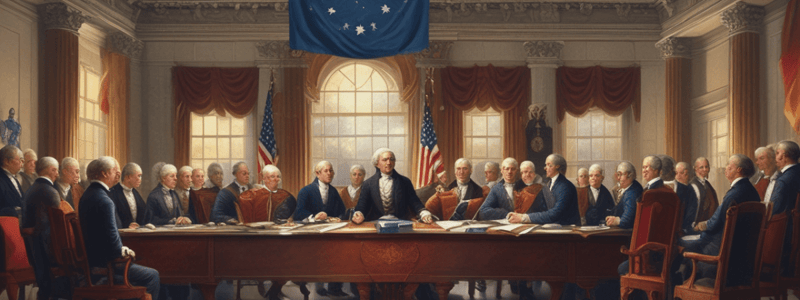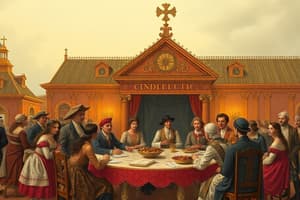Podcast
Questions and Answers
What was the result of the Great Compromise reached at the Constitutional Convention?
What was the result of the Great Compromise reached at the Constitutional Convention?
- The counting of slaves as three-fifths of a person
- The establishment of the new nation’s capital in an area between Virginia and Maryland
- The establishment of the office of president
- The establishment of a legislature of two houses, a House of Representatives based on population and a Senate with equal representation among the states (correct)
Which compromise is known as the 'three-fifths compromise'?
Which compromise is known as the 'three-fifths compromise'?
- The counting of slaves as three-fifths of a person (correct)
- The establishment of the new nation’s capital in an area between Virginia and Maryland
- The establishment of the office of president
- Setting the date for the end of slavery as 1808
Which incorrect statement about the Great Compromise is provided in the text?
Which incorrect statement about the Great Compromise is provided in the text?
- The establishment of a legislature with proportional representation in both houses (correct)
- Setting the date for the end of slavery as 1808
- The counting of slaves as three-fifths of a person
- The establishment of the office of president
What did Article 1, Section 9, Clause 1 stipulate regarding slavery?
What did Article 1, Section 9, Clause 1 stipulate regarding slavery?
What was the major concern Anti-Federalists had about the new Constitution?
What was the major concern Anti-Federalists had about the new Constitution?
Which statement is NOT true regarding the 'three-fifths compromise'?
Which statement is NOT true regarding the 'three-fifths compromise'?
What was the purpose of the Three-Fifths Compromise?
What was the purpose of the Three-Fifths Compromise?
Which of the following freedoms are included in the First Amendment to the U.S. Constitution?
Which of the following freedoms are included in the First Amendment to the U.S. Constitution?
What is the authority of Congress to approve presidential nominees an example of?
What is the authority of Congress to approve presidential nominees an example of?
Why did Alexander Hamilton propose redeeming all bonds at face value and paying all state debts?
Why did Alexander Hamilton propose redeeming all bonds at face value and paying all state debts?
What was the main purpose of the Embargo Act of 1807?
What was the main purpose of the Embargo Act of 1807?
Which group lost significant influence as a result of the War of 1812?
Which group lost significant influence as a result of the War of 1812?
What impact did the Lewis and Clark expedition have on hopes for a Northwest Passage?
What impact did the Lewis and Clark expedition have on hopes for a Northwest Passage?
What was a major consequence of the Embargo Act of 1807 on the United States?
What was a major consequence of the Embargo Act of 1807 on the United States?
Which political party gained influence after the War of 1812?
Which political party gained influence after the War of 1812?
The Sedition Act of 1798 primarily targeted which group of people?
The Sedition Act of 1798 primarily targeted which group of people?
What did the Kentucky and Virginia Resolutions primarily advocate?
What did the Kentucky and Virginia Resolutions primarily advocate?
In which Supreme Court decision was the principle of judicial review of acts of Congress established?
In which Supreme Court decision was the principle of judicial review of acts of Congress established?
Which event resulted in the removal of British presence from the Ohio Valley?
Which event resulted in the removal of British presence from the Ohio Valley?
What was a significant outcome of the Louisiana Purchase?
What was a significant outcome of the Louisiana Purchase?
Which group refused to live within a certain area as per an agreement?
Which group refused to live within a certain area as per an agreement?
What did Jay's Treaty accomplish?
What did Jay's Treaty accomplish?
What was an effect of Marbury v. Madison?
What was an effect of Marbury v. Madison?
Which Supreme Court decision declared slaves as property protected by law?
Which Supreme Court decision declared slaves as property protected by law?
What is nullification in relation to laws passed by Congress?
What is nullification in relation to laws passed by Congress?
Which event tested the unity of the United States under its new Constitution?
Which event tested the unity of the United States under its new Constitution?
Who helped to lay out Washington D.C. and was a mathematician and astronomer?
Who helped to lay out Washington D.C. and was a mathematician and astronomer?
Where did the Federalists party of the 1790s find its support?
Where did the Federalists party of the 1790s find its support?
"It is our true policy to steer clear of permanent alliances, with any portion of the foreign world." This quotation is most likely from a speech by
"It is our true policy to steer clear of permanent alliances, with any portion of the foreign world." This quotation is most likely from a speech by
What did Benjamin Franklin contribute to laying out Washington D.C.?
What did Benjamin Franklin contribute to laying out Washington D.C.?
Which party in the 1790s found its support among poorer farmers in the North?
Which party in the 1790s found its support among poorer farmers in the North?
Who was a famous painter of the period but did not contribute to laying out Washington D.C.?
Who was a famous painter of the period but did not contribute to laying out Washington D.C.?
Flashcards are hidden until you start studying
Study Notes
The Great Compromise
- Established a bicameral legislature with a Senate and House of Representatives.
- The Senate has equal representation for each state, satisfying smaller states' concerns.
- The House of Representatives uses proportional representation based on population, satisfying larger states' wishes.
The Three-Fifths Compromise
- Determined that enslaved people would be counted as three-fifths of a person for representation in the House of Representatives and for taxation purposes.
- This compromise appeased Southern states by granting them more political power.
- It also caused tension and moral arguments about the treatment of enslaved people.
An Incorrect Statement About The Great Compromise
- The text does not provide an incorrect statement about it for us to identify.
Article 1, Section 9, Clause 1
- Prohibited Congress from restricting the slave trade for 20 years.
- This provision represented a significant concession to Southern states.
Major Anti-Federalists Concerns
- They feared a strong central government would erode state sovereignty and individual liberties.
- They expressed anxieties about the potential for tyranny and lack of protection for citizens' rights.
The Three-Fifths Compromise
- The text does not provide a statement that is NOT true about the Three-Fifths Compromise for us to identify.
Purpose of the Three-Fifths Compromise
- It was a compromise reached during the Constitutional Convention to satisfy the concerns of both Southern and Northern states.
- Southern states wanted enslaved people counted for representation but not for taxation, giving them more political power.
- Northern states opposed this idea as it would have given Southern states an unfair advantage.
First Amendment Freedoms
- Religion
- Speech
- Press
- Assembly
- Petition
Presidential Nominee Approval
- Checks and balances
Alexander Hamilton's Bond Redemption Proposal
- He advocated for a unified national debt to create a stronger credit rating.
- It aimed to facilitate economic growth by promoting confidence and stability.
The Embargo Act of 1807
- It aimed to pressure Great Britain and France to cease their attacks on American ships.
- It prohibited American ships from trading with any foreign nation.
Group Losing Influence After the War of 1812
- Federalist Party
Lewis and Clark Expedition and Northwest Passage
- The expedition dispelled the hope for a Northwest Passage through North America.
- It provided valuable scientific and geographical information but ultimately showed the route wasn't feasible.
Embargo Act of 1807 Consequences
- It severely hurt the American economy and led to widespread economic hardship.
- It caused increased unemployment and the decline of US shipping and trade.
Political Party Gaining Influence
- The Democratic-Republican Party
Target of the Sedition Act of 1798
- It targeted Democratic-Republican newspapers and politicians who were critical of the Federalist administration.
Kentucky and Virginia Resolutions
- They argued that the states had the right to nullify federal laws they considered unconstitutional.
- These resolutions marked the first significant challenge to the supremacy of the federal government.
Judicial Review Established
- Marbury v. Madison (1803)
British Presence in Ohio Valley Removal
- Treaty of Paris (1783), ending the Revolutionary War
Louisiana Purchase Outcome
- It doubled the size of the United States, significantly expanding its territory and westward expansion.
- It also led to conflict with Native American tribes whose land was acquired in the purchase.
Group Refusing to Live in a Specific Area
- This question refers to the Trail of Tears, where the Cherokee Nation was forced to relocate to Oklahoma.
Jay's Treaty
- It resolved several outstanding issues between the United States and Great Britain.
- It avoided a possible war and addressed issues of trade and the pre-war debt owed by the US to Great Britain.
Marbury v Madison Effect
- It established the ability of the Supreme Court to declare laws unconstitutional, known as judicial review.
- It empowered the Supreme Court and solidified its role in the system of checks and balances.
Supreme Court Decision on Slavery
- Dred Scott v. Sandford (1857)
Nullification
- The theory that states have the right to invalidate federal laws they deem unconstitutional within their own borders.
- It became a contentious issue during the Jacksonian era, particularly regarding tariffs and states' rights.
Test of US Unity Under its Constitution
- The War of 1812. The war tested the unity of the US when it faced off against Great Britain.
Planner of Washington D.C.
- Pierre Charles L'Enfant
Federalists Party Support
- The Federalist party from the 1790s gained its support from wealthy merchants and industrialists in the North.
"It is our true policy to steer clear of permanent alliances..."
- George Washington
Benjamin Franklin's Washington D.C. Contribution
- He advocated for a city with broad avenues and public squares.
Poor Farmers in the North Support
- The Democratic-Republican Party
Famous Painter of the Period
- Gilbert Stuart. He painted many portraits of prominent figures of the time, including George Washington, but did not contribute to laying out Washington D.C.
Studying That Suits You
Use AI to generate personalized quizzes and flashcards to suit your learning preferences.




